Thank you for Subscribing to Healthcare Business Review Weekly Brief

Draft Occupational Health Article Draft
Healthcare Business Review
Leveraging data to identify trends and improve outcomes is important in Heatlhcare. The analysis of the data is critical and Predictive modeling uses data, machine learning, and various forms of analysis to identify patterns and predict outcomes. There are many tools that can assist in our understanding of healthcare trends and help automate and augment decision making.
Selecting the proper variables to measure is a critical step in understanding outcomes and data trends. Over the past years we have seen an increase in remote work secondary to the COVID 19 pandemic which has impacted the mental health of many workers.
Surveys on mental health and substance use have been conducted by a number of organizations including a health tracking polls by the Kaiser Family Foundation, World Health Organization, and the CDC’s National Center for Health Statistics Household Pulse Survey. These surveys showed a decrease in mental health and helped to provide useful benchmarks for comparisons to other time periods.
In addition, The Center of Disease Control (CDC) provides databases and dashboards on many medical conditions. During the COVID 19 pandemic provisional data from CDC’s National Center for Health Statistics indicate that there were an estimated 75,673 opioid deaths in the 12-month period ending in April 2021, up from 56,064 the year before.
It is important the employers empathize with their workers and begin to understand the stress that the COVID 19 pandemic has placed on them.
Once an employer understands the needs of their employees, they will be in a better position to help support them. Technology has been very helpful in assisting and supporting employees during COVID 19.
Some employees found it difficult to engage with their healthcare professional in person. During the COVID 19 pandemic we saw the expansion of telemedicine in many forms. Many doctors and therapist provided televisits, telerehabilitation, telephysical therapy, and we saw the expansion of teletriage with nurses.
The expansion of these services has helped to begin to end mental health stigma and focus on employee emotional well-being. This has led to the expanded use of self-help applications, digital therapeutics, and for a variety of conditions.
Understanding the importance of maintaining a regular schedule, a health diet, good sleep, and management of chronic medical conditions has resulted in new applications or apps. There are mindfulness apps such as eMindful with can be live or virtual. People can learn new skills to help manage their stress and anxiety.
Other applications deal with the importance of sleep. Sleepio, Oura, Somryst, Muse, Pzizz help with sleep, sleep hygiene, and provide a sleep diary. We saw Weight Watchers Reimagined which helped with diet and companies like Consumer Medical become a medical ally to optimize management of various medical conditions. Other applications and resources deal with Office Ergonomics and setting up you home workstation.
Data from these resources was used to provide feedback and recommendations to the user resulting in improved management of various activities or medical conditions. Some of the technology requires a prescription from a medical provider.
Cognitive Behavioral Therapy can be accessed through Prescription Digital Therapeutic Software such as reSET® and reSET-O®. It is an adjunct to a other healthcare management for patients with Substance Use Disorder (SUD), who are not currently on opioid replacement therapy and increase retention of patients with Opioid Use Disorder (OUD) in outpatient treatment settings by providing cognitive behavioral therapy, as an adjunct to outpatient treatment that includes transmucosal buprenorphine.
There are many other technologies being used in remote patient monitoring and other technologies that are still in development. The appropriate use of technology can lead to improved employee population health, productivity, and retention. Monitoring the appropriate metrics and ensuring employee privacy can allow businesses to provide a supportive and welcoming environment for their employees.









